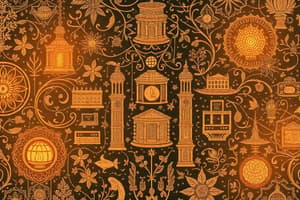Podcast
Questions and Answers
What is a data model primarily used for?
What is a data model primarily used for?
- Describing the structure of a database (correct)
- Establishing security protocols
- Defining user interfaces
- Managing data storage hardware
Which operation is NOT typical of data model operations?
Which operation is NOT typical of data model operations?
- Insert
- Compute
- Delete
- Encrypt (correct)
What type of data model is considered high-level and semantic?
What type of data model is considered high-level and semantic?
- Entity-relationship model
- Conceptual data model (correct)
- Implementation data model
- Physical data model
Which of the following describes a physical data model?
Which of the following describes a physical data model?
What role do constraints play in data models?
What role do constraints play in data models?
Which of the following best describes implementation data models?
Which of the following best describes implementation data models?
Which of the following is a characteristic of conceptual data models?
Which of the following is a characteristic of conceptual data models?
Which category of data models does NOT involve implementation specifics?
Which category of data models does NOT involve implementation specifics?
What defines a database schema?
What defines a database schema?
What is referred to as the initial database state?
What is referred to as the initial database state?
Which of the following examples is NOT a self-describing data model?
Which of the following examples is NOT a self-describing data model?
What is a valid state in a database context?
What is a valid state in a database context?
What best describes the term 'extension' in database terminology?
What best describes the term 'extension' in database terminology?
Which characteristic does the three-schema architecture NOT support?
Which characteristic does the three-schema architecture NOT support?
How often does the database schema typically change?
How often does the database schema typically change?
Which of the following best describes a 'record instance'?
Which of the following best describes a 'record instance'?
What does the internal schema in the three-schema architecture primarily describe?
What does the internal schema in the three-schema architecture primarily describe?
Which data model is typically used for the conceptual schema in the three-schema architecture?
Which data model is typically used for the conceptual schema in the three-schema architecture?
Which of the following is a feature of the Data Manipulation Language (DML)?
Which of the following is a feature of the Data Manipulation Language (DML)?
What is a key advantage of the network model in database management systems?
What is a key advantage of the network model in database management systems?
Which of the following DBMS languages is considered a high-level language?
Which of the following DBMS languages is considered a high-level language?
Which historical data model was supported heavily by CODASYL?
Which historical data model was supported heavily by CODASYL?
What is the primary use of external schemas in the three-schema architecture?
What is the primary use of external schemas in the three-schema architecture?
What was one of the first network DBMS systems implemented?
What was one of the first network DBMS systems implemented?
Which of the following languages is associated with persistent Object-Oriented Programming models?
Which of the following languages is associated with persistent Object-Oriented Programming models?
What trend began with Informix Universal Server in relation to data models?
What trend began with Informix Universal Server in relation to data models?
Which of the following DBMSs is an example of an object-relational system?
Which of the following DBMSs is an example of an object-relational system?
What does the term 'Object-relational' refer to in data models?
What does the term 'Object-relational' refer to in data models?
Which version of the Object Database Standard is noted in the content?
Which version of the Object Database Standard is noted in the content?
Which of the following constructs is used for navigation within databases in the Network Model?
Which of the following constructs is used for navigation within databases in the Network Model?
What is a key disadvantage of the hierarchical data model?
What is a key disadvantage of the hierarchical data model?
Which statement is true regarding the relational model?
Which statement is true regarding the relational model?
Identify the programming language constructs commonly used in the hierarchical model.
Identify the programming language constructs commonly used in the hierarchical model.
What was the main goal of the joint effort between IBM and North American Rockwell in the 1960s?
What was the main goal of the joint effort between IBM and North American Rockwell in the 1960s?
Which of the following is NOT a characteristic of the object-oriented data models?
Which of the following is NOT a characteristic of the object-oriented data models?
Which of the following best describes the relational model's access method?
Which of the following best describes the relational model's access method?
What is a recognized limitation of the network data model's structure?
What is a recognized limitation of the network data model's structure?
Flashcards are hidden until you start studying
Study Notes
Data Models
- A data model is a set of concepts used to:
- Describe the structure of a database.
- Define operations for manipulating data.
- Enforce constraints on data within the database.
- Data Models contain constructs used to define a database's structure.
- These constructs include individual elements (with data types) as well as groupings of elements (like entities, tables, or records)
- Relationships between these groupings of elements are also defined.
- Constraints are limitations on the data that the database can store:
- These must be observed throughout the database's lifetime.
- Data Models are used to define operations:
- These operations allow for retrieving and updating data within the database.
Categories of Data Models
- Conceptual (semantic) data models are high-level and conceptual:
- They are designed to be close to the way users perceive data.
- Physical data models are low-level and internal:
- They describe physical data storage approaches.
- Implementation data models fall between the two.
- They are used by many implemented commercial DBMS systems.
- Self-describing data models combine data descriptions and data values.
- Examples include XML, key-value stores, and some NoSQL systems.
Schemas Versus Instances
- A database schema describes the structure of the database.
- It includes details such as data types and constraints.
- A schema diagram visually represents a database schema.
- A database state is the actual data in the database at any particular time.
- Database state is sometimes called the database instance and is a collection of all data.
Three-Schema Architecture
- The three-schema architecture was created to support:
- Program-data independence: Changes in the physical schema should not cause applications to break.
- Support for multiple views of the data: Different users have different needs and permissions.
- The architecture defines three levels of schemas:
- Internal schema describes physical structures and access paths.
- Conceptual schema describes the structure and constraints of the entire database.
- External schemas define various user views.
DBMS Languages
- Data Definition Language (DDL) is used to define, alter, or delete database objects (Tables, Views, Indexes).
- Data Manipulation Language (DML) is used to retrieve and modify data in the database.
- SQL is an example of a non-procedural high-level language often used with DML.
- Procedural languages are low-level and need to be embedded in a programming language.
History of Data Models
- The Network Model was first implemented in the 1960s.
- It is based on records and set types and uses a navigational language.
- The Hierarchical model was popularized by IBM's IMS family of systems.
- It represents data as a hierarchy and also utilizes a navigational language.
- The Relational Model was introduced by E.F.Codd in the 1970s and uses tables with rows (records) and columns (attributes).
- SQL is the standard language for relational database systems.
- Object-oriented data models are based on data abstraction, objects, and inheritance concepts.
- Object-relational models combine aspects of relational and object-oriented models.
- They have become a dominant way for database vendors to extend systems to support XML, text, and other data types.
Studying That Suits You
Use AI to generate personalized quizzes and flashcards to suit your learning preferences.




